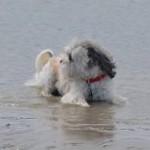
During this time of year, the weather we are experiencing in Perth County is cold and wet. We are seeing a lot of dogs coming into Mitchell Veterinary Services with ear problems.
The floppy part of the ear is known as the “pinna”. We can examine the external ear during the physical exam and we use an otoscope to look into the L-shaped canals to observe the ear drum. Like humans, dogs have glands in their ears that produce ear wax.
Any breed of dog may develop ear infections if there is an underlying cause such as allergies or foreign items in the ear canal which include parasitic ear mites, fur, plant fragments or masses. Ear canals can easily swell shut if inflamed and trap this material.
If dogs have ear infections that are left untreated, they can undergo complications. Infection can burst the ear drum and spread to the middle ear, causing symptoms such as hearing loss and nerve damage. If an ear canal has a long-standing infection, the canal will become scarred and permanently shut and may need to be opened or removed surgically to clear the severe infection.
Predisposing Factors for Ear Infections:
1) Shape – Pendulous ears create a warm, dark and moist environment, which is a breeding ground for yeast and bacteria that may normally be found on the skin in small numbers.
2) Water – Water in the ears from swimming or bathing adds moisture to ears, once again creating the ideal habitat for bad things to grow
3) Trauma – Aggressively cleaning with cotton swabs or plucking ear hair from the canals can injure the skin, allowing an entry point for invaders
4) Environment – Seasonal allergies and food allergies result in a dog with compromised skin that is itchy, weak, inflamed and more vulnerable to invaders.
Dogs’ ears may be at risk for getting a blood blister, also known as an “aural hematoma”, if their ears are allowed to flap vigorously. This flapping creates trauma to the delicate blood vessels in the ear, causing them to burst and fill the space between the skin and cartilage with blood. Two scenarios where this could occur is if a dog rides in the car with their head out of the window or if they have irritated ears from an infection or allergies and shake their head excessively.
Cleaning Your Dog’s Ears
We recommend cleaning out dogs’ ears once a week to once a month, depending on your dogs’ specific needs. For example, dogs that swim benefit from having their ears cleaned right after they come out of the water. An ear cleaner formulated for dogs helps to break up wax and dry out the ear. Please keep in mind that not every cleaning agent is right for all dogs. The goal of keeping your dog’s ears clean is to prevent inflammation (redness, warmth and irritation – scratching and head shaking). Place ear cleaner into the ear and then massage the lower part of the ear canal.
The best way to treat ear infection is for a veterinarian to perform an examination and study material swabbed from the ear under a microscope to determine the type of organisms causing the infection and treat accordingly. A medicated product that treated a dog’s infection in the past may not be appropriate for a current infection. Chronic ear infections typically have a predisposing factor or underlying cause and managing these will be the best way to minimize the ear inflammation in the long run. Contact Mitchell Veterinary Services if you have any questions or concerns about your pet’s ears.


